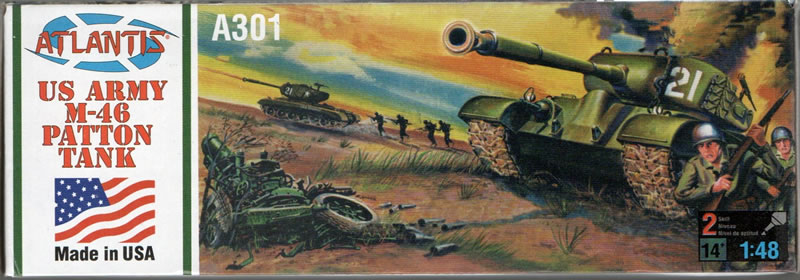
|
Home >
Reviews >
USA >Atlantis (Aurora) Kit No. A301; M-46 Patton Tank |
M-46 Patton Tank
Atlantis (Aurora), 1/48 scale
Reviewed by Cookie Sewell

Summary
| Stock Number and Description |
Atlantis (Aurora) Kit No. A301; M-46 Patton Tank |
| Scale: |
1/48 scale |
| Media and Contents: |
127 parts (125 in olive drab styrene, 2 black vinyl). |
| Price: |
US$21.99 |
| Review Type: |
First Look |
| Advantages: |
Nostalgia release of the first US made styrene armor kit, still reasonably accurate given its age. |
| Disadvantages: |
“Child of the 1950s”, missing a number of details from the actual vehicle and some errors. |
| Recommendation: |
Recommended for Quarter Inch fans as well as nostalgia builders and kids. |

FirstLook
Everything had to start somewhere. Armor kits in the US all lead back to the first three kits released by Aurora in the mid 1950s: the US M46 Patton, the Soviet JS-3 Stalin, and the German Panther. Each kit had a bit over 100 parts which was amazing for that time, vinyl tracks which could be made to work, rotating turrets and elevating guns, and four figures. These three models set the standard for all other kits that followed for nearly 20 years regardless of scale or manufacturer.
Their construction was similar. The hull consisted of four parts – sides, belly and rear plate – with fixed axles for the wheels to roll on. Caps were cemented to the axles trapping the wheels and then the tracks, fastened together by using a heated screwdriver blade, were slipped over the wheels. The upper hull was attached as well as the details like lights, mufflers, hatches, tow cable shackles, and other bits of kit. The turret was assembled to trap a drum assembly so the gun would rotate, and then the assembly was attached to a drum base to permit it to rotate. Final details like machine guns, crew figures, antennas and hatch covers were fitted and then paint and decals to finish it off.
Officially this kit dates to 1956, but I know that I got one in the spring of 1955 from where I was living at the time. I thought it was great to get a tank and was happy until I opened the box. The original directions noted you needed to use a toothpick to get the glue inside of the caps that trapped the wheels if you wanted them to work, and as we had only skinny toothpicks this did not work so well for me. Half of the wheels were forever frozen in place. But when I asked for a candle and a screwdriver to attach the tracks my mother game me a firm “NO WAY” and as a result I had a tank with no tracks. Well, I was six so played with it anyway.
Looking at this kit today it is not too bad, but has a number of either missed items or compromises. The wheels are all pretty basic and missing tires with the oversized caps in the center to fit them to the axles. The tracks make the same errors Tamiya was still making 20 years later in that they attach the connectors to the center of the links and not between them. Lift rings and shackles are sort of like plastic Cheerios and not accurate, and the antennas would scale out to about 2” in diameter in actual size. The machine gun base mount seems to ignore the fact it is supposed to go on top of the gunner’s viewer which is missing. Finally the tank is missing the two large shrouds which go over the twin mufflers; early tank deployments to Korea showed they glow cherry red in the dark and were a giveaway for the tank’s position.
The four figures – commander, loader, driver and bow gunner – are not too bad given their age and with careful trimming and paint will serve their purpose.
The markings are okay and would seem to represent one of the tanks in Korea, but the serials are way too large.
Conclusion
Overall this can be made into a nice model but it will take work and a parts box to finish off if you don’t get too hung up on the wheels and tracks. It would be a good starter model for a kid with dad’s help.
And at least now I can melt the tracks together!
|